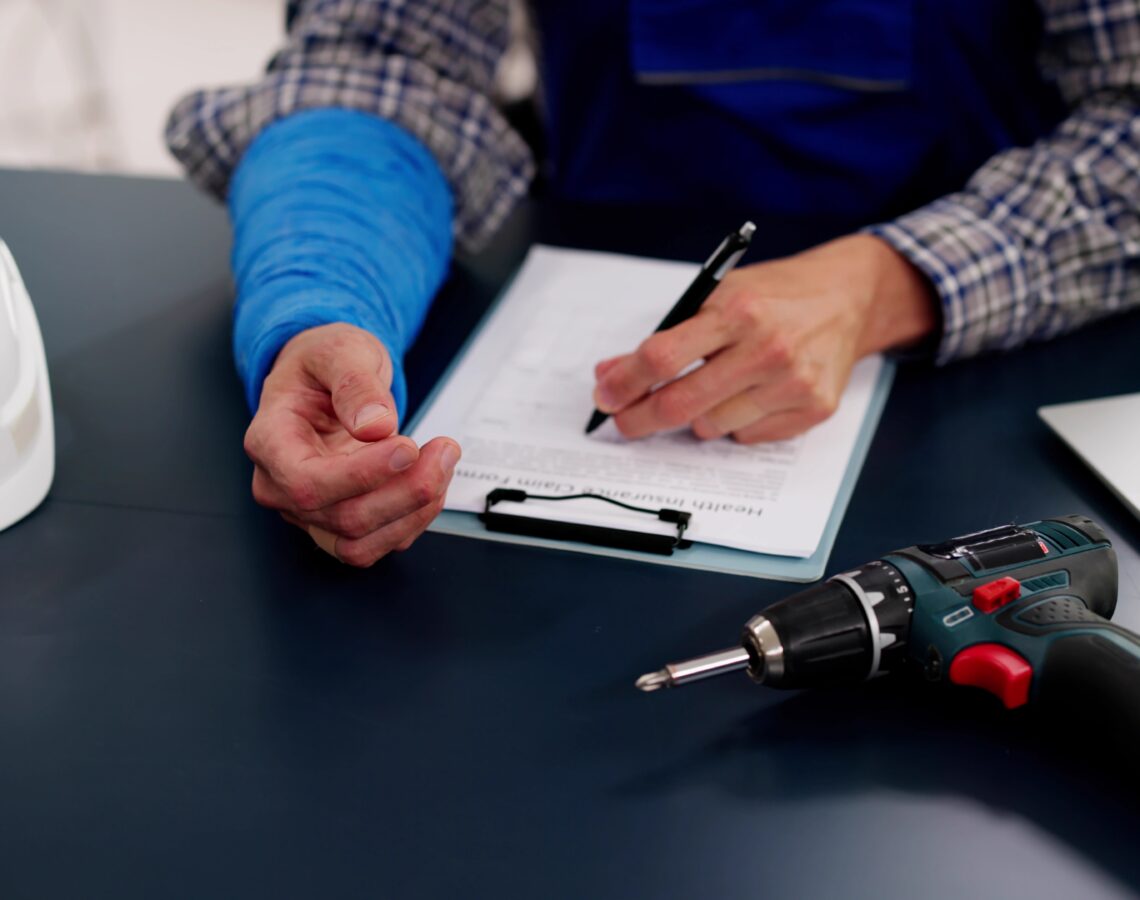What Evidence Do You Need to Prove a Workplace Accident Claim?

Workplace injuries can happen in an instant or develop over time. Whether an employee slips on a wet floor, suffers strain from repetitive motions, or endures trauma from equipment failure, one element remains consistent: a successful claim depends on strong, verifiable evidence.
Indiana’s workers’ compensation system benefits injured employees, but approval is not automatic. A claim must be supported by documentation that connects the injury to the individual’s job duties or work environment.
This guide by Klezmer Maudlin, PC, explains what evidence you need to prove a workplace accident claim and why timely documentation matters. It also addresses concerns about missing or disputed evidence, offering practical steps for employees seeking compensation after a work-related injury. Workplace accident lawyers in Indianapolis can provide invaluable assistance in gathering and presenting the necessary documentation to support your claim and help ensure you receive the benefits you deserve.
Why Evidence Matters in a Workplace Injury Claim
Evidence provides the foundation for a workers’ compensation claim. It allows the claims administrator, employer, or insurance adjuster to determine whether the injury qualifies for benefits under Indiana law.
The burden of proof lies with the injured worker, which means the employee must demonstrate that the injury occurred during employment and that it required medical treatment or caused a disability.
Without supporting documentation, a claim may be denied or delayed. Even when the injury is legitimate, gaps in evidence can raise questions about when and how it occurred. The more precise and consistent the documentation, the more likely the claim will proceed smoothly.
Evidence serves several purposes:
- Establishes that the injury occurred at work or during a work-related activity
- Connects the injury to specific job duties or workplace conditions
- Shows the extent and impact of the injury
- Verifies that proper procedures were followed, such as reporting the injury to a supervisor
Employers and insurance companies will assess every available document and statement. A well-documented claim often results in faster decisions and reduces the likelihood of disputes.
Medical Records and Their Role in a Work Injury Case
Medical documentation plays a central role in proving a workplace injury. These records serve as the primary source for determining the nature, cause, and severity of the injury.
In Indiana, an injured worker is required to seek treatment from a medical provider chosen or approved by the employer or its insurance carrier. These visits produce formal records that can include:
- Initial evaluations
- Diagnostic imaging (X-rays, MRIs, CT scans)
- Progress notes
- Treatment recommendations
- Prescriptions
- Functional capacity evaluations
Each document builds a timeline that links the reported injury to specific medical findings. For example, if a worker reports a back injury on a Friday and visits a physician that same day, the proximity of the two events strengthens the claim. In contrast, delays between the injury and the first medical visit may prompt further scrutiny.
Medical records must be consistent with the description of the injury given to the employer. If an employee tells a supervisor that the injury occurred from lifting boxes but later informs a physician that the pain began at home, that discrepancy can harm the claim.
The treating provider’s opinion about whether the injury is work-related may also influence the claim’s outcome. Workers should be clear and accurate when describing how the injury happened, including whether symptoms appeared immediately or developed over time.
Incident Reports and Employer Documentation
One of the first steps after a workplace injury is reporting it to a supervisor or manager. Indiana law requires prompt reporting, often within a short timeframe set by the employer. A written report from the employer documents the initial details of the incident and becomes part of the claim file.
Incident reports typically include:
- Date, time, and location of the incident
- Description of what occurred
- Names of witnesses
- Reported injuries or symptoms
- Any immediate response actions
Employers may also provide internal records such as safety logs, maintenance reports, or prior complaints about the same hazard. These documents can support the claim by showing that the conditions leading to the injury were known or recurring.
If the employer disputes the injury or claims that it did not happen on the job, the absence or content of the incident report may become a point of contention. Employees who report injuries verbally should always request a formal report be filed and obtain a copy for their records.
In cases where no report was submitted due to fear of retaliation or other concerns, workers may still be eligible for benefits. Still, they will likely need to rely more heavily on different forms of documentation such as medical records, witness statements, or physical evidence.
Witness Statements and Third-Party Testimony
 Eyewitness accounts can support a claim by confirming that the incident occurred and the worker appeared injured. These statements may come from coworkers, supervisors, or others who were present or nearby.
Eyewitness accounts can support a claim by confirming that the incident occurred and the worker appeared injured. These statements may come from coworkers, supervisors, or others who were present or nearby.
A strong witness statement should include:
- The date and time of the observation
- A clear explanation of what the witness saw or heard
- Details about the worker’s condition after the incident
- Any actions taken, such as calling for help or reporting the event
Witness statements are beneficial in cases where there is no video footage or when the employer disputes the injury. They can also help clarify conflicting accounts by providing a third-party perspective.
If there were no witnesses, the employee should document who was nearby and might have seen or heard something relevant. Even if a coworker did not see the injury occur, they may have observed the worker limping, holding an injured arm, or complaining of pain afterward.
In some cases, a third party, such as a customer, vendor, or delivery person, may have witnessed the event. Their testimony can be just as valid, particularly if they are not affiliated with the employer.
Employers may ask witnesses to provide written statements. Workers can also gather their own by speaking with supportive coworkers and encouraging them to submit statements directly to the claims administrator or legal representative.
Physical and Digital Evidence
Photographs, video footage, and digital files can provide a strong visual record of the incident or conditions that led to the injury. These forms of evidence can be particularly effective because they offer objective proof that can be reviewed and analyzed.
Valuable examples of physical or digital evidence include:
- Photos of the scene where the injury occurred
- Images of faulty equipment or unsafe conditions
- Security camera footage showing the incident
- Time-stamped emails reporting the hazard before the injury
- Internal chat logs or messaging records mentioning the incident
- Maintenance logs showing unresolved safety issues
Workers should document conditions as soon as possible after the incident, especially if the hazard might be corrected quickly. A wet floor, broken ladder, or exposed wiring may be removed or repaired within hours, so prompt photos or video can preserve the scene for review.
Employers are not required to provide video footage unless legally obligated, but an attorney may be able to request it through proper legal channels. Workers should note the location of any cameras or digital systems that might have captured the incident and share that information during the claim process.
Even without cameras, digital evidence such as time logs or text messages can demonstrate that the worker was present and performing job duties when the injury occurred.
Payroll and Work Schedule Evidence
Records that confirm the injured employee’s work status at the time of the incident are often overlooked but remain important. Pay stubs, timecards, and work schedules can help reinforce the worker’s presence on-site and their assigned duties at the time the injury occurred.
These documents serve multiple purposes:
- Verify that the employee was on the clock when the injury occurred
- Confirm the location or assignment tied to the employee’s schedule
- Demonstrate consistency between job duties and the reported cause of injury
For example, if a worker claims a fall occurred while loading a shipment, time records showing they were scheduled in the warehouse that day help support the claim. If the employer disputes that the worker was present or authorized to be in a particular area, schedule logs and clock-in data may contradict that argument.
In addition, payroll records can help calculate wage replacement benefits under Indiana workers’ compensation law. Accurate income data is required to determine the appropriate compensation rate for temporary total or partial disability.
Employees should request copies of these records early in the process and retain any pay statements, shift confirmations, or emails discussing work assignment changes.
Long-Term Injury Documentation
Some injuries develop gradually rather than from a single event. Repetitive motion, exposure to harmful substances, or ongoing physical strain can cause long-term damage that may not be immediately obvious. The claim often depends on a detailed medical and occupational history in these situations.
Proving this type of injury involves several forms of documentation:
- Ongoing medical evaluations with consistent references to work-related activity
- Statements from physicians linking the injury to prolonged workplace exposure
- Job descriptions that outline repetitive tasks or physical requirements
- Ergonomic assessments or workplace safety evaluations
- Reports of prior complaints or early symptoms
For instance, a worker with a repetitive strain injury to the shoulder may have seen a doctor multiple times over several months before receiving a formal diagnosis. Each medical visit and each note describing the symptoms and job tasks help build the case.
Consistency also benefits long-term injury claims. Workers should ensure that their accounts remain aligned over time, especially when communicating with different providers or completing official claim documents.
Employers may attempt to argue that the condition resulted from activities outside of work. Workers can respond by showing a lack of relevant activity outside of work, highlighting job-specific tasks, and pointing to prior documentation of complaints made during their employment.
When Evidence Is Disputed or Missing
Not every case includes clear or complete documentation. Workers may encounter situations where the employer refuses to acknowledge the injury, surveillance footage is unavailable, or there are no witnesses present. While these challenges can make the process more difficult, they do not automatically disqualify the claim.
In such cases, other evidence may be substituted or obtained through legal channels. Possible strategies include:
- Providing a detailed personal statement with consistent facts and timelines
- Requesting affidavits from coworkers who observed symptoms or heard complaints
- Submitting documentation of similar past hazards or unresolved safety issues
- Obtaining a medical opinion from an independent provider
- Using legal tools such as subpoenas to access withheld records
Indiana workers’ compensation law allows claims to be based on the weight of the evidence. Benefits may still be awarded if the available documents and testimony support a reasonable conclusion that the injury occurred during work duties.
Workers should document all interactions with supervisors, human resources personnel, and medical staff. Even informal communications, such as emails or memos, can support the claim when formal records are lacking.
An Indiana workers’ compensation lawyer can help with gathering substitute forms of documentation and responding to denials due to a lack of evidence.
Legal Support for Building a Strong Claim
 Gathering and presenting evidence can be time-consuming, especially while recovering from an injury. In many cases, workers may be unsure what qualifies as helpful documentation or how to respond to an employer’s dispute. Legal assistance offers practical advantages during this process.
Gathering and presenting evidence can be time-consuming, especially while recovering from an injury. In many cases, workers may be unsure what qualifies as helpful documentation or how to respond to an employer’s dispute. Legal assistance offers practical advantages during this process.
Workplace accident attorneys can:
- Help identify and collect supporting documents early in the process
- Prepare formal written statements and gather corroborating testimony
- Submit record requests to employers, healthcare providers, or third parties
- Address inconsistencies or missing documentation through supplemental evidence
- Manage communications with the insurance company to prevent misinterpretation
For cases involving surveillance footage, policy violations, or long-term injuries, legal support may also include coordinating with medical professionals to provide detailed evaluations or preparing the worker for a hearing before the Indiana Workers’ Compensation Board.
Workers should consider contacting legal counsel promptly after reporting the injury. Early involvement can help preserve evidence, prevent communication errors, and build a stronger case.
Delays in documentation or misstatements to a claims adjuster can reduce the likelihood of approval. A well-organized claim file, supported by accurate records and reliable statements, significantly improves the chances of receiving full benefits.
Get Help With Your Indiana Workplace Accident Claim
Recovering from a workplace injury takes time, and pursuing benefits should not add to the stress of the process. Legal representation can make a difference if you are dealing with delays, denials, or a lack of response from your employer or the insurance company.
At Klezmer Maudlin, our workplace accident lawyers focus exclusively on workers’ compensation and have represented over 31,000 injured workers across Indiana. Our attorneys are deeply familiar with the state’s workers’ compensation system and have contributed to shaping how the law is applied in real-world cases. We’re also proud to serve as personal injury lawyers in Indianapolis, offering experienced representation for those injured due to negligence.
Whether you’re unsure how to proceed or are already facing resistance to your claim, we can help you pursue the benefits you’re entitled to under Indiana law. That includes payments for medical treatment, lost income, and long-term disability when applicable.
For a free consultation, call 317-569-9644 or complete the contact form on our website. We will discuss your situation and answer any questions you have.

